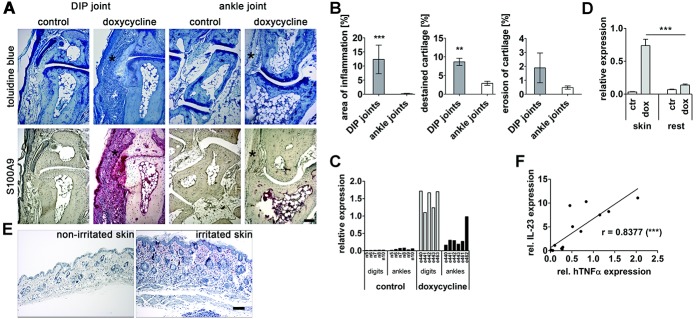Figure 3.

Distal interphalangeal (DIP) joints but not ankle joints are severely inflamed in doxycycline-inducible human TNFα–transgenic mice after stimulation with doxycycline. Doxycycline-inducible human TNFα–transgenic mice were treated with 0.5 mg/ml doxycycline for 6 weeks or left untreated (control). A, Staining of serial sections of hind paws with toluidine blue (top) or antibodies to S100A9 protein (red) (bottom). Asterisks indicate a strong synovitis in DIP joints but not ankle joints of doxycycline-treated mice. B, Quantification of inflammation (left), cartilage destaining (middle), and cartilage erosion (right) by morphometry (n = 4 mice per group). ∗∗ = P < 0.01; ∗∗∗ = P < 0.001 versus ankle joints. C, Expression of human TNFα transcripts in hind paw digits and ankles, quantified by TaqMan quantitative reverse transcription–polymerase chain reaction (RT-PCR). Values for separate numbered animals are presented. D, Quantitative RT-PCR analysis of human TNFα expression in the skin and the rest of the tissues of hind paws (n = 5 mice per group). ∗∗∗ = P < 0.001. E, S100A9 staining (red) of a healthy skin section and an irritated (see http://zmbe.uni-muenster.de/vwixler/retser.zip) skin section from a doxycycline-treated mouse. Nuclei (blue) were counterstained with hematoxylin. F, Relationship between human TNFα and interleukin-23 (IL-23) mRNA transcripts in skin samples from doxycycline-treated mice (n = 12 mice). ∗∗∗ = P < 0.001. Bars = 100 μm. Values in B and D are the mean ± SEM. See Figure 1 for other definitions.
